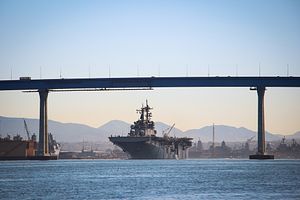The U.S. Navy has quietly dispatched the Essex Amphibious Ready Group (ARG), consisting of the Wasp-class amphibious assault ship USS Essex, the San Antonio-class amphibious transport dock USS Anchorage, and the Whidbey Island-class dock landing ship USS Rushmore, to the Western Pacific last week, a U.S. defense official confirmed to USNI News on July 12.
The USS Essex with a crew of over 1,000 officers and sailors departed San Diego on July 10 carrying a squadron of F-35Bs, the U.S. Marine Corps’ short take-off and vertical landing (STOVL) variant of the supersonic fifth-generation F-35B Lightning II Joint Strike Fighter. The departure of the ARG along with the 13th Marine Expeditionary Unit (MEU) was not announced publicly before it left San Diego last Tuesday.
“The Essex Amphibious Ready Group with embarked 13th Marine Expeditionary Unit got underway from San Diego, Tuesday,” U.S. Pacific Fleet spokesman Captain Charlie Brown said in a July 13 statement to USNI News. “For reasons of operational security, we are not publicly disclosing any additional details.”
The ARG/MEU, consisting of around 5,000 sailors and Marines, is expected to deploy to the Western Pacific and the Middle East. While previous deployments of ships have been publicly announced, last week’s departure of the ARG/MEU was reportedly kept quiet as a result of an order by the new U.S. Pacific Fleet commander Admiral John Aquilino.
“The communications move was designed to change the expectations on what information the public could expect when ships in the Pacific area of operations deploy,” USNI News reports.
The 40,000-ton USS Essex can carry around 31 aircraft, including F-35Bs, AV-8B Harrier IIs, MH-60S Knighthawk helicopters, AH-1Z Viper helicopters, and MV-22 Osprey tiltrotor aircraft. It can also embark around 2,300 assault troops and support equipment. Following modifications to its flight deck, the Essex can carry up to six F-35Bs.
“With the new aircraft, we want to be able to capitalize on all the capability that aircraft has to bear, like multi-functional data links, how do we get that information from that airplane to the ship so we can use it,”Amphibious Squadron 1 commander, Captain Gerald Olin, told USNI News in February. “That also gives me additional command-and-control capability.”
The Essex’s sister ship, USS Wasp, was the first amphibious assault ship to operate the F-35B from its flight deck earlier this year. It deployed to the Western Pacific in January 2018–the ship’s first operational deployment in the Indo-Pacific region, where it has conducted routine patrols and participated in numerous naval exercises.
For example in April, the USS Wasp trained alongside the Japan Maritime Self Defense’s (JMSDF) Osumi-class amphibious transport dock JS Shimokita in the Sea of Japan.
In addition to the F-35Bs currently en route to the Indo-Pacific region, the U.S. Marine Corps operates a squadron of 16 F-35Bs out of Iwakuni airbase in Yamaguchi Prefecture, Japan–the service’s first overseas-deployed F-35B squadron.

































